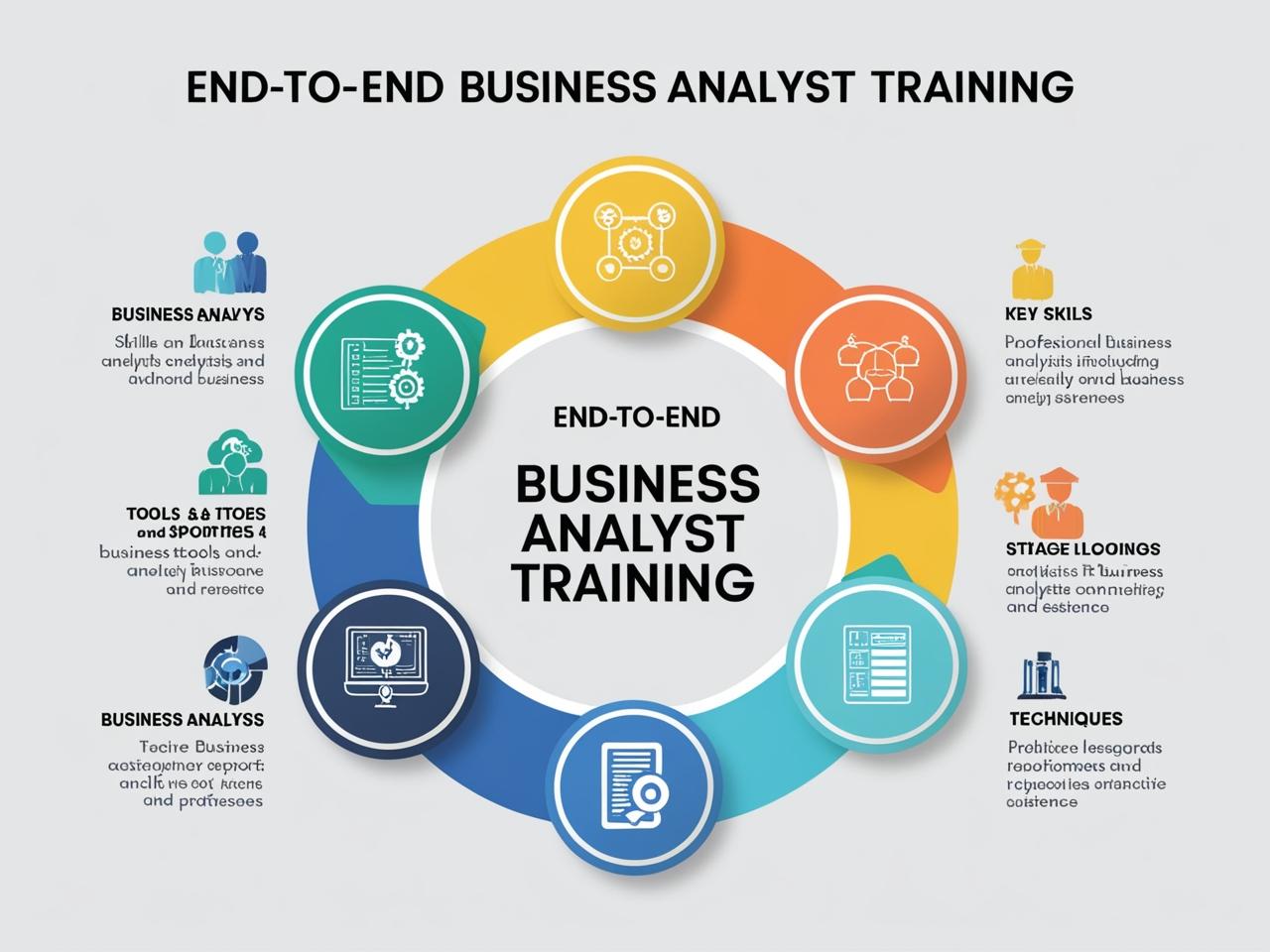Business Analysts (BAs) play a crucial role in understanding business needs and transforming them into actionable solutions. They work across various industries, helping businesses improve processes, services, and products. This end-to-end business analyst training will cover essential skills, tools, and techniques that will help you succeed in the BA role.
What is Business Analysis?
Business analysis is the practice of identifying business needs and finding technical solutions to business problems. A business analyst works closely with stakeholders to gather requirements, document them, and ensure the final solution meets business goals and expectations.
Key Skills of a Business Analyst
To excel as a Business Analyst, one must possess a diverse set of skills, ranging from technical know-how to strong communication abilities. Here are the essential skills you need:
1. Analytical Thinking
A Business Analyst needs strong analytical skills to examine business processes, understand complex problems, and break them down into manageable parts. Analyzing data and identifying trends is critical for formulating effective solutions.
2. Problem-Solving
A good BA identifies the core problems faced by a business and suggests feasible solutions. This requires creativity and critical thinking to solve issues efficiently and cost-effectively.
3. Communication Skills
Effective communication is key to working with stakeholders, clients, and team members. A Business Analyst must be able to clearly explain technical concepts to non-technical individuals, ensuring that everyone is on the same page.
4. Detail-Oriented
Business Analysts must be able to pay attention to small details and document them precisely. Inaccuracies in requirements or specifications can lead to major issues in project outcomes.
5. Stakeholder Management
Understanding and managing stakeholders is essential in gathering the right requirements and ensuring alignment with business goals. Building relationships and managing expectations are critical components of a BA’s role.
6. Time Management
BAs often juggle multiple tasks simultaneously, from documenting requirements to conducting meetings. Effective time management ensures that deadlines are met and priorities are managed effectively.
Essential Tools for a Business Analyst
Business Analysts rely on various tools to streamline their work, improve efficiency, and collaborate effectively with teams. Here are some popular tools that BAs use in their day-to-day work:
1. Microsoft Excel
Excel remains one of the most versatile tools for data analysis and reporting. From creating pivot tables to conducting data analysis, Excel helps BAs analyze data and generate reports quickly.
2. Business Process Modeling Notation (BPMN) Tools
BPMN tools like Lucidchart or Bizagi Modeler allow BAs to map out complex business processes visually. These tools help stakeholders understand processes, identify inefficiencies, and make improvements.
3. JIRA
JIRA is commonly used in Agile projects to track requirements, manage tasks, and facilitate communication between team members. It helps BAs track the progress of requirements and ensures that tasks are completed on time.
4. Visio
Microsoft Visio is used for creating flowcharts, process diagrams, and other visual representations of business processes. It’s an essential tool for BAs when presenting data in a way that is easy for non-technical stakeholders to understand.
5. Trello
Trello is a popular project management tool that helps BAs organize tasks, prioritize work, and track progress. It provides a user-friendly interface for creating boards, lists, and cards that help with project tracking.
6. Google Analytics
For digital projects, Google Analytics is invaluable in tracking website traffic, user behavior, and performance metrics. BAs use this tool to identify areas for improvement and analyze the impact of changes on business outcomes.
Read more: https://trendingblogsweb.com/how-to-enhance-supply-chain-performance-with-ai-and-ml/
Key Techniques Used by Business Analysts
Business Analysts employ a variety of techniques to elicit requirements, model processes, and validate solutions. Below are some commonly used techniques:
1. Requirements Elicitation
One of the primary tasks of a BA is to gather requirements from stakeholders. Several techniques are used to elicit these requirements, such as:
- Interviews: Conducting one-on-one discussions with stakeholders to understand their needs.
- Workshops: Interactive group sessions where stakeholders collaboratively define requirements.
- Surveys/Questionnaires: Collecting data from a larger group of stakeholders to gather insights.
- Observation: Analyzing how a process works by observing it in action.
2. SWOT Analysis
SWOT (Strengths, Weaknesses, Opportunities, Threats) analysis is used by BAs to assess the internal and external factors affecting the business. This technique helps identify areas for improvement and potential opportunities for growth.
3. Use Case Modeling
Use cases are used to describe how a system will interact with external entities. This technique is commonly used to capture functional requirements and scenarios that a system must handle.
4. Flowcharts and Diagrams
BAs use flowcharts and diagrams to visually represent processes, workflows, or systems. This helps stakeholders understand complex processes and identify inefficiencies. Flowcharts are especially useful in process mapping.
5. Impact Analysis
Impact analysis helps BAs determine the consequences of proposed changes or new systems on existing processes, systems, or infrastructure. This technique is vital in ensuring that changes will not disrupt business operations.
6. Gap Analysis
Gap analysis is used to assess the difference between the current state and the desired future state of a business. By identifying the gap, BAs can recommend solutions to bridge it and improve business performance.
7. Prototyping
Prototyping involves creating a working model of the system or solution to gather feedback early in the development process. This helps refine requirements and ensures that the final product meets user expectations.
8. Agile Methodology
Agile is a popular methodology in business analysis, especially in software development. BAs working in Agile environments are responsible for gathering and prioritizing requirements, facilitating communication between teams, and ensuring that the solution aligns with customer needs.
Best Practices for Business Analysts
To be an effective Business Analyst, it’s important to follow best practices to ensure successful outcomes. Here are some key practices:
1. Understand the Business Context
A thorough understanding of the business, its objectives, and its challenges is essential. This knowledge helps BAs propose solutions that align with organizational goals.
2. Collaborate with Stakeholders
Regular communication and collaboration with stakeholders are vital. Engaging stakeholders early and often helps in gathering accurate requirements and managing expectations.
3. Document Requirements Clearly
Clear, concise, and accurate documentation is crucial in business analysis. BAs should ensure that requirements are easily understood by all stakeholders, both technical and non-technical.
4. Stay Adaptable
In the fast-paced world of business analysis, being flexible and open to change is important. Business needs evolve, and so should your analysis methods.
5. Focus on Continuous Improvement
Business Analysts should continuously seek ways to improve processes, products, and services. This involves staying updated with industry trends, new tools, and techniques.
Conclusion
Business Analysts play a pivotal role in bridging the gap between business needs and technical solutions. By developing key skills, using the right tools, and applying effective techniques, you can thrive in this dynamic and rewarding field. Enrolling in Business Analyst classes in Noida, Delhi, Pune, Bangalore, and other parts of India can help you gain the necessary expertise. Continuous learning and adapting to new trends and technologies will help you stay ahead in the ever-evolving business landscape.





